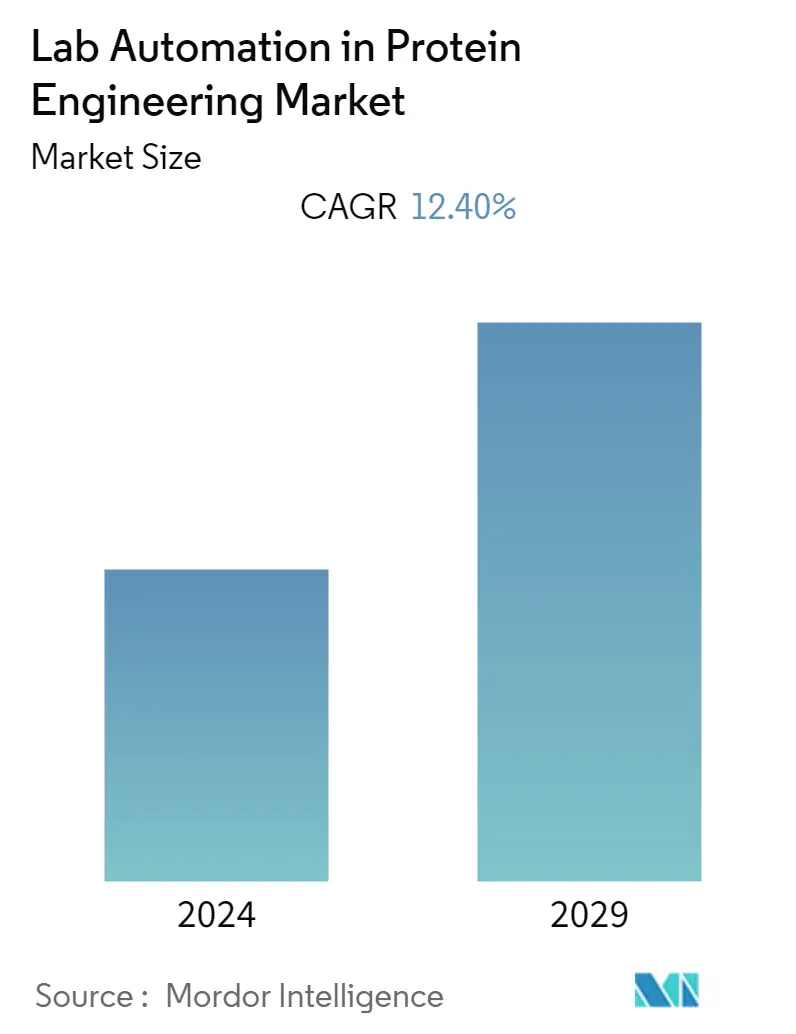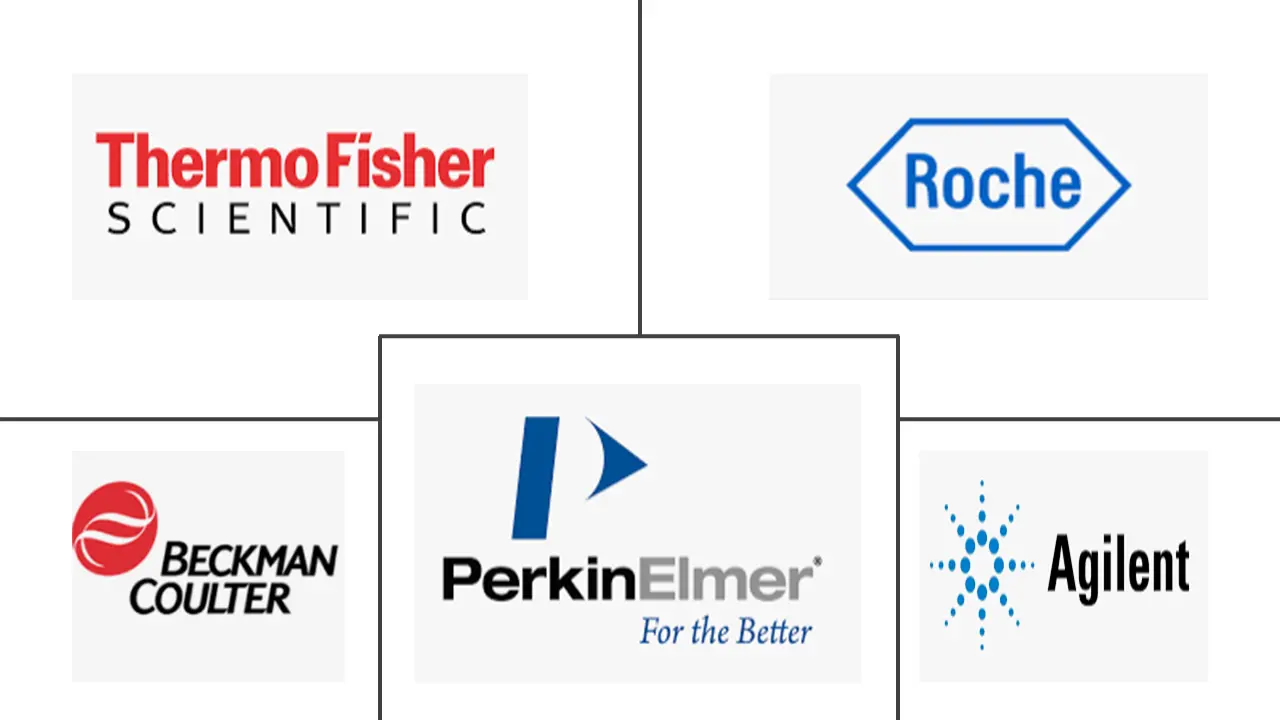Market Size of Lab Automation in Protein Engineering Industry

| Study Period | 2019 - 2029 |
| Base Year For Estimation | 2023 |
| CAGR | 12.40 % |
| Fastest Growing Market | Asia-Pacific |
| Largest Market | North America |
| Market Concentration | Medium |
Major Players
*Disclaimer: Major Players sorted in no particular order |
Lab Automation in Protein Engineering Market Analysis
Lab automation in the protein engineering market is expected to register a CAGR of 12.4% over the forecast period. Protein engineering automation can aid scientists in deciphering and solving the mysteries of protein malfunction, such as misfolding, aggregation, and unusual movement. As a result, more effective medication discovery will be possible. One of the primary drivers for automation in the protein engineering industry is the fast-expanding demand for protein medications over non-protein pharmaceuticals and the increased prevalence of lifestyle disorders.
- Protein-energy malnutrition (PEM) is rising in emerging economies' rural communities. It refers to a collection of illnesses that includes kwashiorkor, marasmus, and marasmus-kwashiorkor transitional phases. As a result, the incidence of kwashiorkor varies by region. It is pretty uncommon in the United States. Central America, Southeast Asia, Congo, Jamaica, Puerto Rico, and South Africa are impacted. As a result, the rising frequency of protein-deficiency illnesses boosts total market demand.
- The healthcare business has been affected by a growing number of government efforts, such as sponsoring R&D for protein engineering and awareness programs. As a result, the government is funding several research initiatives ahead of time. For example, Protein Technologies Ltd (PTL) obtained money from the UK government's Technology Strategy Board (now Innovate UK) for their ground-breaking protein engineering research.
- Protein engineering also has great potential in the agrochemical business because it can lead to better-functioning enzymes, boost crop yields, or make biofuel production easier. It is also anticipated to play a vital role as a technique for achieving the higher agricultural outcomes required to satisfy future needs.
- Since the outbreak of COVID-19, labs have been turning their premises and resources into COVID-19 testing facilities, increasing automation equipment use. The University of Washington's laboratories were the first to do so. The statement came after the Broad Institute announced that its clinical processing lab would be converted into a large-scale COVID-19 testing facility.
Lab Automation in Protein Engineering Industry Segmentation
Scientists always look for improved accuracy, higher throughput, and reduced cost during advanced gene sequencing. An automated system allows laboratories to increase the effectiveness of their workstation for protein engineering. In the past few years, protein engineers have successfully generated a wide range of proteins tailored to specific health, industry, medicine, research, and biotechnology applications.
The Lab Automation in Protein Engineering Market is segmented by Equipment (Automated Liquid Handlers, Automated Plate Handlers, Robotic Arms, and Automated Storage and Retrieval Systems) and Geography. The market sizes and forecasts are provided in terms of value (USD million) for all the above segments.
| By Equipment | |
| Automated Liquid Handlers | |
| Automated Plate Handlers | |
| Robotic Arms | |
| Automated Storage and Retrieval Systems (AS/RS) | |
| Other Equipment |
| By Geography | |
| North America | |
| Europe | |
| Asia-Pacific | |
| Rest of the World |
Lab Automation in Protein Engineering Market Size Summary
The lab automation in protein engineering market is experiencing significant growth, driven by the increasing demand for protein-based medications and the rising prevalence of lifestyle disorders. Automation technologies are crucial in addressing challenges such as protein misfolding and aggregation, thereby enhancing drug discovery processes. The market is further bolstered by government initiatives supporting research and development in protein engineering, as well as the growing incidence of protein-energy malnutrition in various regions. Additionally, the agrochemical sector is exploring protein engineering to improve enzyme functionality and agricultural productivity, highlighting the broad applicability of these technologies.
In North America, the market is highly competitive due to the presence of major pharmaceutical companies and contract research organizations, which are increasingly adopting robotics and automation to maintain a competitive edge. The genomic industry, particularly in the United States, is poised for growth, driven by advancements in genome sequencing technologies and an aging population. The market is characterized by moderate competition, with key players focusing on technological advancements, partnerships, and mergers and acquisitions to enhance their offerings. Recent innovations, such as automated sample preparation systems and robotic track systems, are set to further streamline laboratory processes and reduce manual labor, underscoring the ongoing evolution of lab automation in protein engineering.
Lab Automation in Protein Engineering Market Size - Table of Contents
-
1. MARKET INSIGHTS
-
1.1 Market Overview
-
1.2 Value Chain/Supply Chain Analysis
-
1.3 Industry Attractiveness - Porter's Five Forces Analysis
-
1.3.1 Threat of New Entrants
-
1.3.2 Bargaining Power of Buyers
-
1.3.3 Bargaining Power of Suppliers
-
1.3.4 Threat of Substitute Products
-
1.3.5 Intensity of Competitive Rivalry
-
-
1.4 Assessment of the COVID-19 Impact on the Industry
-
-
2. MARKET SEGMENTATION
-
2.1 By Equipment
-
2.1.1 Automated Liquid Handlers
-
2.1.2 Automated Plate Handlers
-
2.1.3 Robotic Arms
-
2.1.4 Automated Storage and Retrieval Systems (AS/RS)
-
2.1.5 Other Equipment
-
-
2.2 By Geography
-
2.2.1 North America
-
2.2.2 Europe
-
2.2.3 Asia-Pacific
-
2.2.4 Rest of the World
-
-
Lab Automation in Protein Engineering Market Size FAQs
What is the current Lab Automation in Protein Engineering Market size?
The Lab Automation in Protein Engineering Market is projected to register a CAGR of 12.40% during the forecast period (2024-2029)
Who are the key players in Lab Automation in Protein Engineering Market?
Agilent Technologies Inc., Thermo Fisher Scientific , PerkinElmer, Inc., Beckman Coulter Inc. and Roche Holding AG are the major companies operating in the Lab Automation in Protein Engineering Market.

